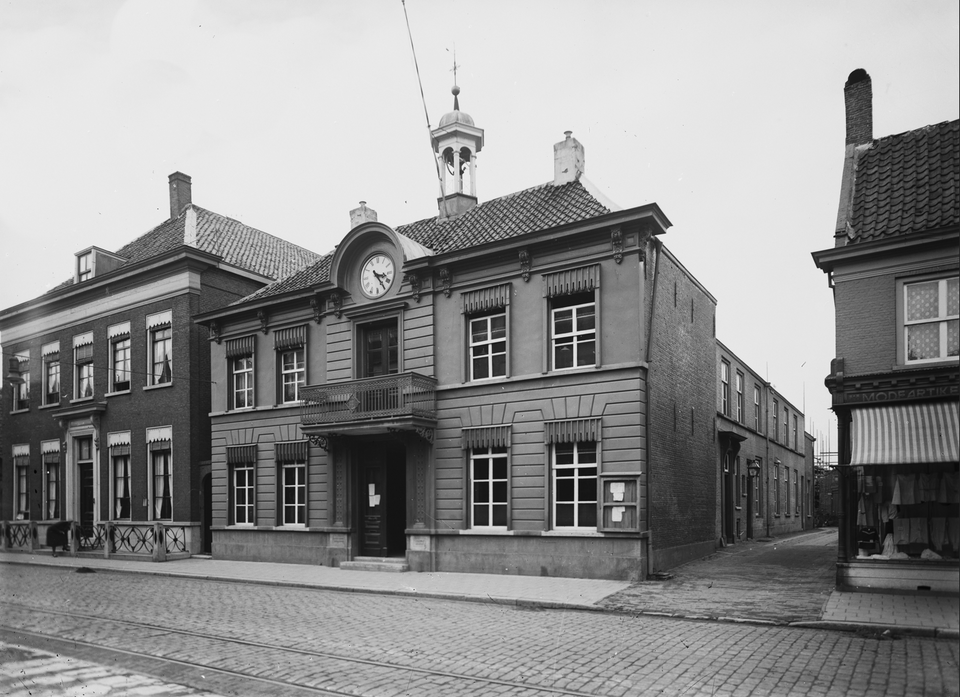Attention stone - Waalwijk town hall
Waalwijk Town Hall (1855-1932)
On the occasion of the anniversary "Waalwijk: 100 years together," 24 attention stones were laid in the municipality. The selected objects (cinema, monastery, cattle market, town hall, union building and shoe industry) in Waalwijk center played a role at the time of the re-division (1922). On this website you will find the bicycle route 'On the road in the historical Langstraat', which leads past these stones.
Until 1773, the municipal government met primarily in a council chamber, at the home of sheriff or s...
Waalwijk Town Hall (1855-1932)
On the occasion of the anniversary "Waalwijk: 100 years together," 24 attention stones were laid in the municipality. The selected objects (cinema, monastery, cattle market, town hall, union building and shoe industry) in Waalwijk center played a role at the time of the re-division (1922). On this website you will find the bicycle route 'On the road in the historical Langstraat', which leads past these stones.
Until 1773, the town council met mainly in a council chamber, in the home of the sheriff or aldermen, or in a local inn. In this year the guesthouse chapel was rebuilt. Until the great city fire of June 25, 1824, this former guesthouse chapel was in use as the town hall of Waalwijk. This town hall stood on the site where later the headquarters of the N.V. 'Noord-Braband - Maatschappij van Verzekering op het Leven' (Grotestraat 341) was built. A memorial stone, bricked into the rear facade of the office building, recalls the fire that struck the town hall. The restoration of the first council house and its contents presented many problems. Of course, the most important part of the inventory, the archives, could not be replaced. For a number of administrative records, duplicates could
duplicates could be produced. Already the day after the fire, new registers of the Civil Registry were requested to restore the pre-fire records. At the end of the year, a Royal Decree determined that the registers of the Civil Registry from 1811 to 1824 could be copied by the clerk of the justice of the peace court. In February 1825, action was again taken to obtain funds to rebuild the town hall. On May 17, 1825, the final "No" came from the governor and Provincial States. The city council resigned itself to the fact that the town hall would not be rebuilt.
Brewery
Due to lack of finances, the city council decided only in 1854 to purchase and renovate property, yard, garden and brewery "De Roode Leeuw," owned
of J. Vincent Hoffmans (Antwerp), to purchase and renovate. The turret on the roof and the new façade, equipped with a 'capital entrance,' gave the building a dignified appearance. The clock was added later. The town hall had a police station, a room for the district court, a room for the clerk's office and a room for the civil registry. There was also a meeting room, a "best room," a secretary's office and archive storage on the second floor. In 1856, the brewery behind the town hall was demolished. After rebuilding the council house, it also housed: a military barracks, house of detention with six prison cells, jailer's and constable's house, police room and a room for the newly established drawing school. From January 1, 1855 to October 22, 1932, the building served as a town hall and district court.
De Gruyter
In 1933, the building was demolished to make way for a grocery store owned by P. de Gruyter & Zn. There was much opposition from the local middle class to the arrival of the chain store. In order to get the city council on board, it was stipulated that the gallery and the bandstand would also be paid for by De Gruyter. By buying the adjacent building from H. Wiesman, the store could be expanded in 1962. With this renovation, the gallery entrance disappeared, and the main entrance came on the east side.
